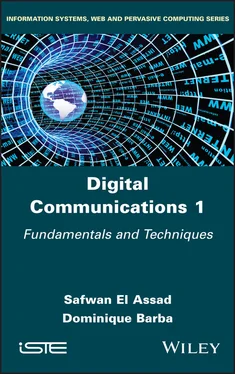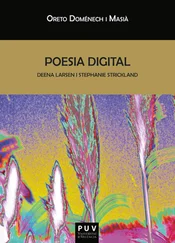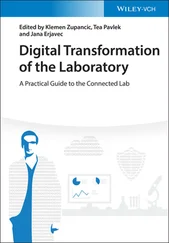1 Cover
2 Title page
3 Copyright First published 2020 in Great Britain and the United States by ISTE Ltd and John Wiley & Sons, Inc. Apart from any fair dealing for the purposes of research or private study, or criticism or review, as permitted under the Copyright, Designs and Patents Act 1988, this publication may only be reproduced, stored or transmitted, in any form or by any means, with the prior permission in writing of the publishers, or in the case of reprographic reproduction in accordance with the terms and licenses issued by the CLA. Enquiries concerning reproduction outside these terms should be sent to the publishers at the undermentioned address: ISTE Ltd 27–37 St George’s Road London SW19 4EU UK www.iste.co.uk John Wiley & Sons, Inc. 111 River Street Hoboken, NJ 07030 USA www.wiley.com © ISTE Ltd 2020 The rights of Safwan El Assad and Dominique Barba to be identified as the authors of this work have been asserted by them in accordance with the Copyright, Designs and Patents Act 1988. Library of Congress Control Number: 2020936357 British Library Cataloguing-in-Publication Data A CIP record for this book is available from the British Library ISBN 978-1-78630-541-1
4 Foreword
5 Part 1: Theory of Information
Introduction to Part 1
1 Introduction to Telecommunications
1.1. Role of a communication system 1.2. Principle of communication 1.3. Trend towards digital communications 2 Measurement of Information of a Discrete Source and Channel Capacity2.1. Introduction and definitions 2.2. Examples of discrete sources 2.3. Uncertainty, amount of information and entropy (Shannon’s 1948 theorem) 2.4. Information rate and redundancy of a source 2.5. Discrete channels and entropies 2.6. Mutual information 2.7. Capacity, redundancy and efficiency of a discrete channel 2.8. Entropies with k random variables 3 Source Coding for Non-disturbance Channels3.1. Introduction 3.2. Interest of binary codes 3.3. Single decoding codes 3.4. Average codeword length 3.5. Capacity, efficiency and redundancy of a code 3.6. Absolute optimal codes 3.7. K-order extension of a source 3.8. Shannon’s first theorem 3.9. Design of optimal binary codes 4 Channel Coding for Disturbed Transmission Channels4.1. Introduction 4.2. Shannon’s second theorem (1948) 4.3. Error correction strategies 4.4. Classification of error detection codes or error correction codes 4.5. Definitions related to code performance 4.6. Form of the decision 4.7. Linear group codes 4.8. Cyclic codes 4.9. Linear feedback shift register (LFSR) and its applications
6 Part 2: Baseband Digital Transmissions and with Carrier Modulation Introduction to Part 2 5 Binary to M-ary Coding and M-ary to Signal Coding: On-line Codes5.1. Presentation and typology 5.2. Criteria for choosing an on-line code 5.3. Power spectral densities (PSD) of on-line codes 5.4. Description and spectral characterization of the main linear on-line codes with successive independent symbols 5.5. Description and spectral characterization of the main on-line non-linear and non-alphabetic codes with successive dependent symbols 5.6. Description and spectral characterization of partial response linear codes 6 Transmission of an M-ary Digital Signal on a Low-pass Channel6.1. Introduction 6.2. Digital systems and standardization for high data rate transmissions 6.3. Modeling the transmission of an M-ary digital signal through the communication chain 6.4. Characterization of the intersymbol interference: eye pattern 6.5. Probability of error Pe 6.6. Conditions of absence of intersymbol interference: Nyquist criteria 6.7. Optimal distribution of filtering between transmission and reception 6.8. Transmission with a partial response linear coder 7 Digital Transmissions with Carrier Modulation7.1. Introduction and schematic diagram of a digital radio transmission 7.2. Multiple access techniques and most common standards 7.3. Structure of a radio link, a satellite link and a mobile radio channel 7.4. Effects of multiple paths and non-linearities of power amplifiers 7.5. Linear digital carrier modulations 7.6. Quadrature digital linear modulations: general structure of the modulator, spatial diagram, constellation diagram and choice of a constellation 7.7. Digital radio transmission and equivalent baseband digital transmission: complex envelope 7.8. Equivalent baseband transmission, interest and justification: analytical signal and complex envelope 7.9. Relationship between band-pass filter H and equivalent low-pass filter He 7.10. M-ary Phase Shift Keying Modulation (M-PSK) 7.11. M-ary Quadrature Amplitude Modulation (M-QAM) 7.12. Detailed presentation of 16-QAM modulation and demodulation 7.13. Amplitude and Phase Shift Keying Modulation (APSK) 7.14. Detailed presentation of the 8-PSK modulation and demoludation 7.15. Performances of modulations in spectral occupancy and efficiency
7 References
8 Index
9 End User License Agreement
1 Introduction to Part 1 Figure I1.1.General structure of a digital communications system and its proble...
2 Chapter 1 Figure 1.1.Simple communication system. For a color version of this figure, see... Figure 1.2. Modes of communication:  source;
source;  recipient Figure 1.3. Type of networks Figure 1.4.Principle of communication. For a color version of this figure, see ... Figure 1.5. Digital communication system
recipient Figure 1.3. Type of networks Figure 1.4.Principle of communication. For a color version of this figure, see ... Figure 1.5. Digital communication system
3 Chapter 2 Figure 2.1. Entropy of a two-event source Figure 2.2.Basic transmission system based on a discrete channel. For a color v... Figure 2.3. Ambiguity on the symbol at the input when yj is received Figure 2.4. Uncertainty on the output when we know the input Figure 2.5. Binary symmetric channel Figure 2.6. Variation of the capacity of a BSC according to p
4 Chapter 3 Figure 3.1.Classification of codes. For a color version of this figure, see www...
5 Chapter 4 Figure 4.1. Simplified block diagram of the communication system Figure 4.2. Exponent of the error probability Figure 4.3. Error correction strategies Figure 4.4. Hamming encoder Figure 4.5. Hamming decoder Figure 4.6. Extension of the Hamming encoder Figure 4.7. Extension of the Hamming decoder Figure 4.8. Divider circuit Figure 4.9. Divider circuit pre-multiplied by xk Figure 4.10. Efficient encoder Figure 4.11. Example of encoder operation at each clock cycle Figure 4.12. Division circuit by g(x), general case Figure 4.13. Pre-multiplied division circuit by xk, general case Figure 4.14. Encoder based on division circuit pre-multiplied by xk Figure 4.15. Decoder based on division circuit pre-multiplied by xk Figure 4.16. Linear feedback shift register Figure 4.17. Linear feedback shift register encoder Figure 4.18. Linear feedback shift register decoder Figure 4.19. Block diagram of the encoder Figure 4.20. Block diagram of the decoder Figure 4.21.Coding by multiplication. For a color version of this figure, see w... Figure 4.22.State of the register at each clock cycle. For a color version of t... Figure 4.23. M-sequence generator Figure 4.24. 4-cell M-sequence generator Figure 4.25.Symmetric NRZ signal of the output sequence (sequence generator of ... Figure 4.26. Autocorrelation function of an M-sequence Figure 4.27. Power spectral density of an M-sequence Figure 4.28. Generator of Gold sequences Figure 4.29. Sequences generator of the large Kasami set Figure 4.30. Block diagram of a stream encryption/decryption system Figure 4.31. Internal structure of Trivium
Читать дальше

 source;
source;  recipient Figure 1.3. Type of networks Figure 1.4.Principle of communication. For a color version of this figure, see ... Figure 1.5. Digital communication system
recipient Figure 1.3. Type of networks Figure 1.4.Principle of communication. For a color version of this figure, see ... Figure 1.5. Digital communication system










